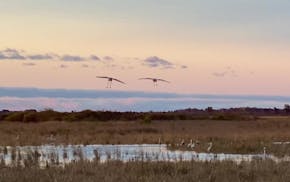One of the least regarded birds in most back yards is that small, dark sparrow hopping around on top of the snow. These black-eyed birds with the charcoal-colored hood and back and white stomach are closely associated with the arrival of winter. Dark-eyed juncos earn a quick glance in October, when they suddenly arrive from Canada, but then are largely ignored for the rest of the winter.
And that's a shame, because juncos are fascinating little birds, easily recognizable and worth a second look. When people talk about "snow birds," this is the bird they mean. (In fact, these birds are so closely associated with the onset of cold and snow that a winter-averse friend says, each fall, "If you see a junco, don't tell me about it!")
Cold hardy
Here's a typical winter scenario: It's early morning in February, the temperature hovers near 10 below, and it's still fairly dark. I can tell, by their size and shape, that 10 cardinals are foraging under the pine tree, accompanied by some smaller birds. After first light, I can discern that the little birds hopping around the edges of the cardinal group are juncos.
These are hardy, hardworking birds: They're up early and stay out past dusk, scrabbling on the ground for seeds and food that drops out of feeders. Juncos are the quintessential ground feeders, with much of their seed diet in warmer weather supplied by ragweed, foxtail and crabgrass. They keep a close eye on the local squirrels and flit in to feed after a squirrel has left an area, knowing that the rodents may have dropped small bits of food, a perfect fit for their small, conical beaks.
White flash says it all
Juncos give us many opportunities to realize, "Aha, it's a junco," which may be partly why we take them for granted. Often while walking through a grassy area in a park or open space we'll spot a group of small birds up ahead, along the path. If they're just a bit too far away to identify, we wonder what species of ground-hopping birds these are. They inevitably flush as people approach, and if you see a flash of white feathers along the birds' tails, you can safely call them juncos.
Is the white flash as they spread their tails a warning to others in the flock to take cover, or is it meant as just a small distraction, allowing the bird time to escape a predator? It may be both.
These little sparrows make a long journey, from the boreal forest in Canada, to spend the winter among us. When they return to their breeding grounds in the spring, they'll build small nests on the forest floor, making them vulnerable to many kinds of predators. Like some other ground-nesters, junco nestlings are able to run before they can fly, scattering from their nest if a hungry chipmunk or squirrel approaches.
They're everywhere
Every state in the union hosts juncos in winter (we see the slate-colored race of these birds, one of five junco subspecies, each with different colorations), and they're one of the more populous birds around. During each winter's Cornell Lab of Ornithology Project FeederWatch, juncos invariably rank among the top three most frequently reported back-yard birds.
Any day now, as the sun sets later and later, juncos will begin to head north to court and breed. Before they do, though, they'll sing one of the prettiest little trills in the bird kingdom, a sound that signals spring is on its way (hear juncos here: www.allaboutbirds.org/guide/Dark-eyed_Junco/sounds).
St. Paul resident Val Cunningham, who leads bird hikes for the St. Paul Audubon Society and writes about nature for local, regional and national newspapers and magazines, can be reached at valwrites@comcast.net.

Want to share info with the Star Tribune? How to do it securely

A Minnesota field guide to snow shovels: Which one's best?
Sign up for Star Tribune newsletters
